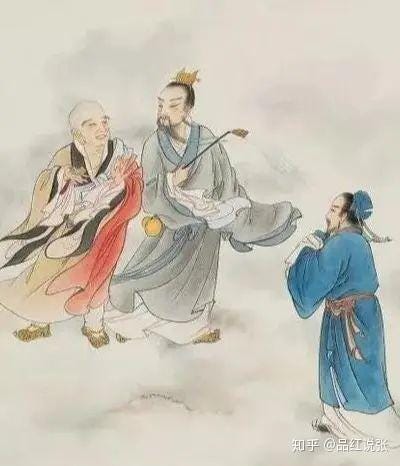When Does The Story Finally Start?
Okay — it’s time for some reflection.
What we’ve seen so far in Dream of the Red Chamber is probably the opposite of what you expected. In fact, the first time I read this novel I was worried that I was reading the wrong book. It seemed to me that there was simply nothing interesting going on, and that the whole book was an incoherent mess.
Think about it. The 9 translation posts we’ve covered so far include:
A cryptic introductory commentary on the whole work.
Riffing on a somewhat obscure Chinese myth.
A monk and a priest find a stone and offer to make it mortal.
A different priest finds the stone at the end of the story and reads the things inscribed on its surface.
This second priest gets into an argument with the stone about its story and the state of contemporary Chinese fiction.
The author then explains the history of the names of this book.
We finally meet an actual person: Zhen Shiyin, who sits in his study and falls asleep.
We go into Zhen Shiyin’s dream, where the monk and priest come back and start talking about the bureaucracy of the celestial realm.
The monk and priest start talking about how a bunch of grass wanted to repay a debt it felt it had to a stone — and that it could only repay this debt by becoming mortal and crying all the time.
Is this going anywhere? Is this even a real book? Can you think of any classics in world literature with such a confused and cluttered beginning?
Now, the truth is that Chinese fiction wasn’t just a bunch of crazy symbols and references that are nearly impossible to understand. Instead, Cao Xueqin deliberately decided to write his book in a subversive manner, eschewing all conventional wisdom.
It’s not hard to see this. Compare the beginning we’ve just seen with the beginnings of some of the other famous works of Chinese fiction:
三國演義 Romance of the Three Kingdoms
After a somewhat epic beginning, we meet the main characters. For example, Liu Bei is introduced by the 10th paragraph:
玄德幼時,與鄉中小兒戲於樹下,曰:「我為天子,當乘此車蓋。」
When Xuande (later Liu Bei) was a child, he played with the other village children under a tree, saying, “When I become the Son of Heaven, I will ride under this chariot canopy.”
水滸傳 Water Margin
This book starts off in the court:
當有殿頭官喝道:「有事出班早奏,無事捲簾退朝。」只見班部叢中,宰相趙哲,參政文彥博出班奏曰:「目今京師瘟疫盛行,傷損軍民甚多。伏望陛下釋罪寬恩,省刑薄稅,祈禳天災,救濟萬民。」
At that moment, a court official announced loudly, "Those with matters to address, step forth and present them early. If there are none, the screen shall be rolled up, and the court dismissed."
Then, from the ranks of officials, Prime Minister Zhao Zhe and Counselor Wen Yanbo stepped forward and presented this memorial:
"At present, a plague is rampant in the capital, claiming the lives of many soldiers and civilians. We humbly beseech Your Majesty to pardon offenses, show leniency, reduce punishments, lighten taxes, and pray for divine intervention to avert this calamity—so that the people may be relieved."
西遊記 Journey to the West
After the scene is set, we meet a group of monkeys right away. For example, this is from the 8th paragraph:
一群猴子耍了一會,卻去那山澗中洗澡。見那股澗水奔流,真個似滾瓜湧濺。
A group of monkeys played for a while, then went to bathe in the mountain stream. They saw the torrent rushing down, churning and splashing like rolling melons.
It’s not long before we meet Sun Wukong.
金瓶梅 Plum in the Golden Vase
Even this book, with all of its aggressive sexuality and hidden philosophic and literary wit, has a conventional beginning. After a somewhat moralizing (and ironic) introduction, we’re introduced right away to an actual person. This is from the 8th paragraph:
話說大宋徽宗皇帝政和年間,山東省東平府清河縣中,有一個風流子弟,生得狀貌魁梧,性情瀟灑,饒有幾貫家資,年紀二十六七。
During the Zhenghe era of Emperor Huizong of the Great Song Dynasty, in Qinghe County of Dongping Prefecture, Shandong Province, there lived a dissolute young man. He was powerfully built and dashing in demeanor, possessed of considerable family wealth, and about twenty-six or twenty-seven years of age.
Now, I hate to spoil too much for you, but the truth is that we’re not going to get to the “love story” of Jia Baoyu and Lin Daiyu until the second chapter. While both characters are mentioned in the first chapter indirectly (Jia Baoyu is the stone and the “divine jade servant;” Lin Daiyu is the fairy flower), we don’t get to know either one of them.
In fact, the more I think about it, the more puzzled I am by this decision. I can’t think of any self-respecting novel that doesn’t bother to introduce the main characters in the first chapter. I don’t think anybody in the world of literary fiction would recommend even trying this.
So why did Cao Xueqin compose his book like this?
Keep reading with a 7-day free trial
Subscribe to Dream of the Red Chamber to keep reading this post and get 7 days of free access to the full post archives.





